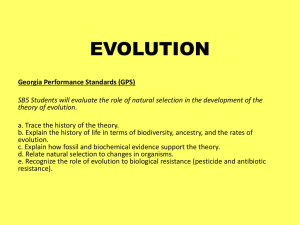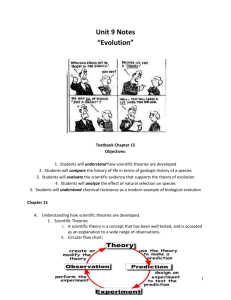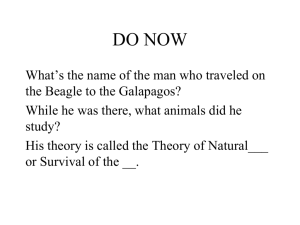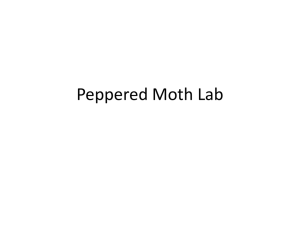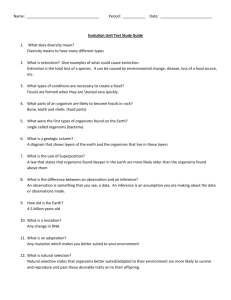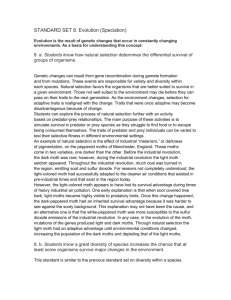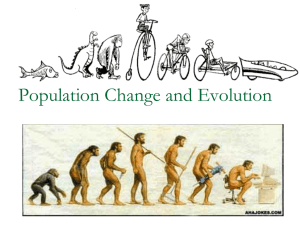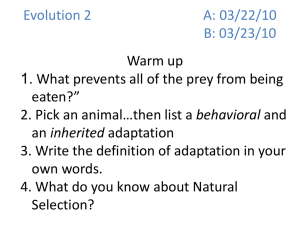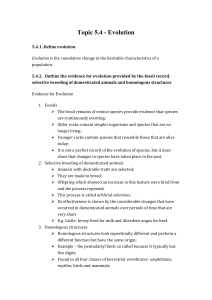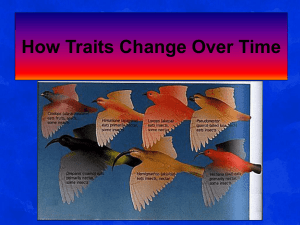Evolution EOCT
advertisement
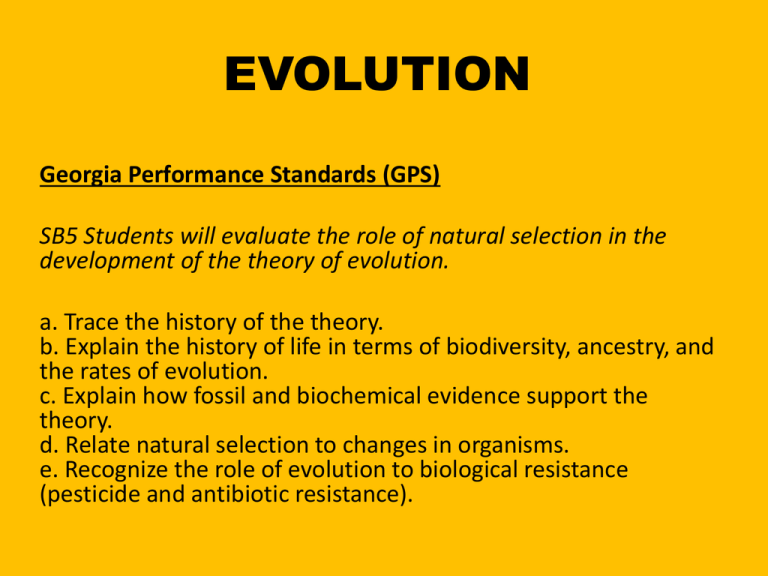
EVOLUTION Georgia Performance Standards (GPS) SB5 Students will evaluate the role of natural selection in the development of the theory of evolution. a. Trace the history of the theory. b. Explain the history of life in terms of biodiversity, ancestry, and the rates of evolution. c. Explain how fossil and biochemical evidence support the theory. d. Relate natural selection to changes in organisms. e. Recognize the role of evolution to biological resistance (pesticide and antibiotic resistance). Theory of Evolution by Natural Selection • Lamarck– Theory of Use/Disuse- if you don’t use a part you will lose it. – Inheritance of Acquired Traits- an organism obtains a trait during life (large muscles) so offspring are born with that trait – No longer accepted theory • Darwin – Descent w/modificationorganisms come from a common ancestor – Natural Selection • • • • • All organisms produce more offspring than can survive. All offspring are genetically varied (may not always be obvious based on phenotype) Variations in genes enable some offspring to outcompete others Those with negative traits die, taking those to the grave. Those with positive traits survive, reproduce, and pass on to offspring. Eventually the entire POPULATION evolves- changes gradually over time. Types of Natural Selection • Directional- population moves from one extreme to the other • Disruptive/Diversifying- extreme phenotypes are favored – Light and dark are favored, medium stick out • Stabilizing- average phenotypes are favored – Plants- short plants can’t compete for sunlight so they die, tall plants can’t withstand winds so they die, this leaves medium height trees In peppered moths there are two major phenotypes- light color and dark color Before the Industrial Revolution: After the Industrial Revolution: •Light moths blend in, dark moths stick out, dark get eaten •Dark phenotype gets eaten so not very common so the dark allele is not frequent •Dark moths blend in, light moths stick out, light get eaten •Light phenotype gets eaten so not very common so the light allele becomes less frequent This change in the moth population over time is EVOLUTION of a population. Change in Moth Phenotype from 1800’s-1900’s Notice the peak of the blue line is over the light phenotype 120 Notice the peak of the red line is over the dark phenotype 100 80 Moth Population Before Industrial Revolution 60 After Industrial Revolution 40 20 0 very light light medium dark very dark Phenotypes of Moths This shows that the population evolved from light being more common before Industrial revolution to dark after. This type of natural selection is called Directional selection Patterns of Evolution 1. Adaptive Radiation (divergent evolution) – – Many species evolve from a common ancestor EX: Darwin’s finches 2. Coevolution – – 2 species evolve in response to each other EX: fast cheetahs vs. faster gazelles 3. Convergent Evolution – – 2 different species evolve to have the same trait b/c they live in similar environments EX: Madagascar aye-aye & New Guinea striped opossum both have elongated middle finger for digging bugs out of trees but live in different parts of the world. Rates of Evolution 1. Gradualism • Small, gradual steps • Traits remain unchanged for millions of years 2. Punctuated Equilibrium • Abrupt transitions • Seen in fossil record • Rapid spurts of genetic change caused divergence quickly 1. Disease Resistance • Bacteria are becoming resistant to antibiotics b/c of the misuse of antibiotics. Bacteria are building resistance. • Insects are also building resistance to pesticides due to overuse & improper use of the chemicals. • Industrial melanism- peppered moths changed due to pollution. • Generally, organisms that are more general in their needs survive. A species that requires a specific food source or habitat will be less able to change. 2. Artificial Selection • Genetically modified foods • Selective breeding in dogs & plants (crops) http://www.pbs.org/wgbh/evolution/educator s/lessons/lesson6/act1.html What are some current trends in evolution? Evidence for Evolution • Fossils- compare fossils to look for evidence of change over time • Biogeography- compare locations of organisms to find common ancestors • Homology – Homologous structurescomparing structural similarities – Molecular similarities- comparing DNA btwn organisms – Vestigial structures- parts no longer have a fxn (appendix, wisdom teeth) but may have in an ancestor – Embryological evidencecomparing embryo development to see relationships Cladograms/Phylogenetic Trees 1. Show evolutionary relationships 2. Like a family tree Cladograms/Phylogentic Trees • Which two animals are more closely related? Chimp & Bonobo • Which two animals are least closely related? Gibbon & Human Classification key/Dichotomous key1. Type of tool used to identify unknown organisms. 2. Use a series of steps to identify an organism starting with its most general traits & ending with its most specific traits. How to read one: 1.Read 1st two statements. Which ever is correct about your organism, follow the instructions. Keep doing this until you reach a scientific name. 2.See example on next slide Bird W Geospiza Bird X Platyspiza Bird Y Certhidea Bird Z Camarhynchus Scientific Naming Rules 1. Written in Latin- old language/never changes 2. Italicized when typed; underlined when written 3. First word is genus name- capitalized 4. Second word is species name- lowercase • Species name can represent: • Color- ex: Acer rubrum is a red maple • Who discovered it- ex: Friula wallacii is a spider discovered by Wallace • Place where discovered- ex: Aplysia californica is a California Sea Hare Domain Eukarya Kingdom Animalia Phylum Chordata Class Mammalia Order Primates This is the classification for a human Family Hominidae Genus Homo Species sapien Our scientific name is Homo sapien
